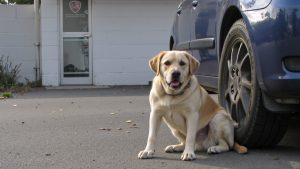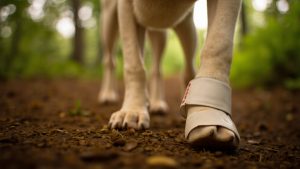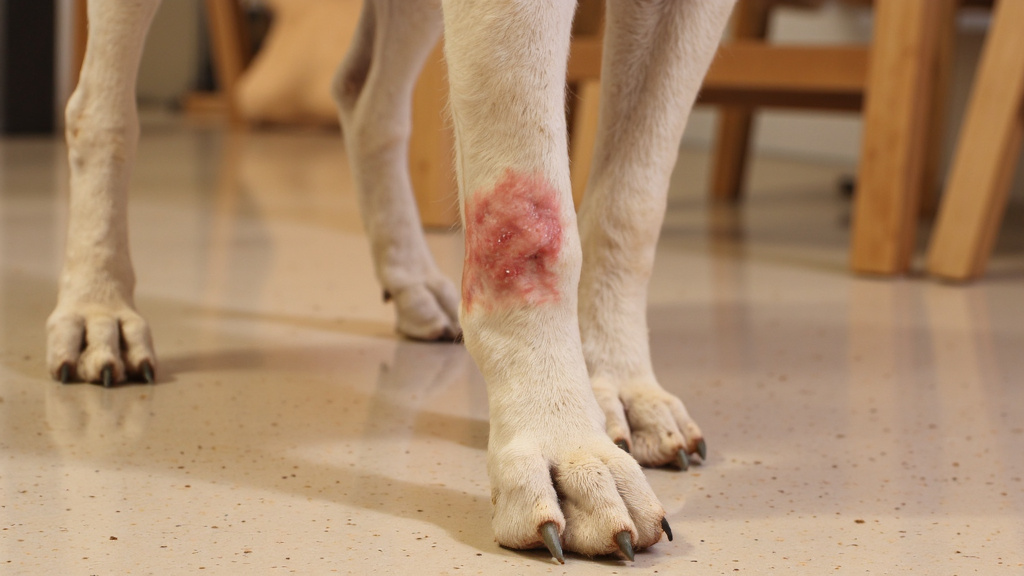
When your dog suddenly starts obsessively licking and scratching a spot on their leg, parting the fur reveals an angry red patch that wasn’t there before. This is a hot spot, and it requires immediate attention.
Hot spots, medically known as acute moist dermatitis or pyotraumatic dermatitis, are painful, rapidly-developing areas of skin inflammation in dogs. These red, irritated patches can appear suddenly, becoming moist, oozing, and unpleasantly odorous. What’s particularly concerning is their rapid expansion – a small irritated area can grow into an alarmingly large wound within hours.
Dogs intensely lick, bite, or scratch the affected area, creating a cycle that worsens the condition. This trauma breaks down the skin’s protective barrier, allowing bacteria to multiply and infection to spread. Early detection and prompt treatment are essential to provide relief before significant discomfort develops.
What Are the Signs of Hot Spots in Dogs?
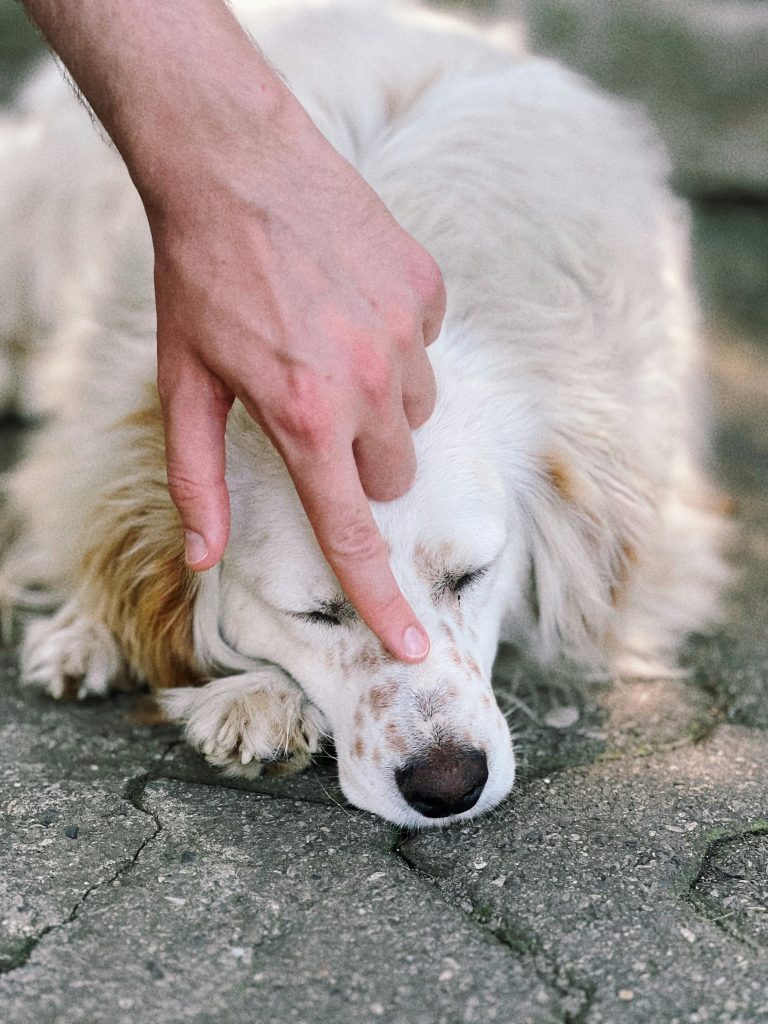
When your dog obsessively licks or scratches at a particular spot that appears suddenly, it could be a hot spot developing. Hot spots (acute moist dermatitis) are troublesome skin conditions that cause serious discomfort for dogs, and early recognition can prevent unnecessary suffering.
Visual Indicators of Hot Spots
Hot spots have distinct characteristics that make them identifiable during regular check-ups. The affected area appears as a well-defined patch of inflamed, bright red skin that contrasts sharply with your dog’s normal skin tone. These lesions feel hot to the touch, hence their name.
Hot spots can develop alarmingly fast. A small irritated area can expand to several inches in diameter within 24 hours, making immediate attention crucial when you notice unusual skin changes.
Key Symptoms to Watch For
- Redness and inflammation: The affected area will appear noticeably red, raised, and swollen
- Excessive heat: The spot feels warm or hot when gently touched
- Moisture and discharge: The area often appears wet, oozing clear fluid or yellowish pus
- Hair loss: Fur around and on the hot spot may fall out or be licked away
- Unpleasant odor: A distinctive musty or foul smell often develops as bacteria multiply
- Crusty or scabbed edges: As the hot spot develops, its borders may form crusts or scabs
Behavioral Changes That Signal Discomfort
Dogs with hot spots display noticeable behavioral changes. The intense itching drives them to seek relief through various actions. You may observe your dog engaging in excessive licking or chewing at the affected area, sometimes creating self-inflicted wounds that worsen the condition.
Dogs with hot spots often become irritable. They may snap or whine when you examine the affected area, even if normally tolerant of handling. Some dogs shake their head repeatedly if the hot spot is near their ears or face, while others rub against furniture or carpet to scratch hard-to-reach spots.
Common Locations for Hot Spots
While hot spots can develop anywhere on your dog’s body, certain areas are particularly susceptible:
- Head and face: Particularly around the ears, eyes, and cheeks
- Neck and throat: Often under the collar area where friction occurs
- Hip and thigh region: Especially in dogs with mobility issues
- Base of tail: Common in dogs with flea allergies or anal gland problems
- Chest and abdomen: Particularly in dogs that lick these areas when stressed
Progression Stages of Hot Spots
Understanding how hot spots develop can help you catch them early:
Early stage: A small, red, irritated area that your dog may begin to lick or scratch. The area might appear slightly moist.
Intermediate stage: The spot expands, becoming increasingly red and moist. Hair loss becomes apparent, and the area may begin to ooze discharge.
Advanced stage: The hot spot grows significantly larger, potentially covering several square inches. The discharge may become purulent, developing a strong odor. The surrounding skin becomes increasingly inflamed.
Distinguishing Hot Spots from Other Skin Conditions
Not all red, irritated spots are hot spots. The distinctive features include rapid onset and expansion, moist lesions, and intense behavioral responses. Unlike ringworm or chronic allergic dermatitis, hot spots develop quickly and have a characteristic moist, oozing appearance.
Regular skin checks are essential for early detection. Run your hands through your dog’s coat during petting sessions, feeling for unusual warmth, moisture, or tenderness that might indicate a developing problem.
| Condition | Appearance | Common Locations | Key Symptoms |
|---|---|---|---|
| Hot Spots | Red, moist, oozing patches | Head, neck, hips | Rapid onset, itching, odor |
| Ringworm | Round, scaly lesions | Face, paws, ears | Hair loss, mild itching |
| Allergic Dermatitis | Red, inflamed skin | Face, belly, paws | Persistent itching, swelling |
What Causes Hot Spots on Dogs?

Hot spots develop when bacteria enter damaged skin, creating painful, inflamed patches that can spread rapidly. Understanding what triggers these troublesome skin problems is essential for prevention.
Allergy-Related Triggers
Dogs with allergies are particularly susceptible to hot spots. When allergens cause itching, scratching creates small skin breaks where bacteria enter. Common triggers include food allergies to proteins like chicken or beef, and environmental allergens such as pollen, dust mites, or mold spores.
Flea allergy dermatitis is especially concerning. Dogs with this condition can develop intense itching from just a single flea bite, explaining why some dogs develop hot spots during peak flea season despite minimal visible parasites.
Moisture and Grooming Issues
Trapped moisture creates ideal conditions for bacterial growth. Thick-coated breeds like Golden Retrievers, Labrador Retrievers, and German Shepherds are particularly vulnerable after swimming or bathing. Without proper drying, dense undercoats can trap moisture against the skin.
Matted fur worsens this issue by preventing proper airflow. Regular brushing isn’t just cosmetic—it’s crucial for preventing these infections. Hot spots commonly develop in areas where mats form, such as behind the ears or under the collar.
Pain and Discomfort
Dogs often lick painful areas. Ear infections can lead to hot spots from scratching the ears and surrounding areas. Dogs with arthritis may excessively lick painful joints, creating conditions for hot spots. This pattern explains why older dogs sometimes develop recurring hot spots over joint areas.
Behavioral and Psychological Factors
Physical discomfort isn’t the only trigger for excessive licking. Stress, anxiety, and boredom can all contribute to hot spot development. Dogs with separation anxiety or those frequently left alone may develop hot spots through compulsive licking.
Research confirms that canine stress behaviors directly impact skin health. A bored or anxious dog may persistently lick one area, eventually compromising the skin’s protective barrier.
| Allergy-Related Triggers | Food allergies, environmental allergens like pollen and dust mites, flea allergy dermatitis |
| Moisture and Grooming Issues | Water trapped against the skin, matted fur |
| Pain and Discomfort | Ear infections, arthritis leading to excessive licking |
| Behavioral and Psychological Factors | Stress, anxiety, boredom leading to excessive licking |
When your dog develops a hot spot, consider potential triggers. Did it appear after swimming? During allergy season? Following a stressful event? Identifying the underlying cause is essential for prevention. While a single hot spot might be isolated, recurring issues typically indicate a specific trigger that needs attention.
How Can You Treat Hot Spots at Home?
When angry red patches appear on your dog’s skin, quick action makes a difference. Hot spots—painful, inflamed skin lesions—respond well to prompt home treatment when caught early. With the right approach, you can help your dog find relief while healing begins.
Gather Your Supplies First
Collect everything needed: blunt-tipped scissors or clippers, antiseptic solution, clean cotton balls or gauze, a towel, and an e-collar. Having supplies within reach prevents interrupting treatment, reducing stress for both you and your dog.
Step 1: Trim the Hair Around the Hot Spot
Exposing the hot spot to air is crucial for healing. Carefully trim the hair around and above the affected area using clippers on the lowest setting or blunt-tipped scissors. Extend about an inch beyond the visible irritation, as hot spots often spread beneath the fur. If your dog seems uncomfortable or the spot is in a difficult location, seek professional help rather than risking injury.
Step 2: Clean the Affected Area
Proper cleaning removes bacteria and debris that worsen infection. Use a mild antiseptic solution such as diluted chlorhexidine (available at pet stores) or make a simple saline solution by mixing one teaspoon of salt with two cups of warm water. Gently dab—don’t rub—the area with soaked cotton balls or gauze until all discharge and debris are removed. Pat dry with a clean, soft cloth.
Avoid using hydrogen peroxide or alcohol on hot spots. These harsh solutions damage healthy cells and can delay healing while causing unnecessary pain.
Step 3: Apply an Appropriate Topical Treatment
After cleaning, apply a suitable treatment to promote healing:
- Veterinary options: Products containing hydrocortisone can reduce inflammation, while antibacterial sprays like Vetericyn Plus Antimicrobial Pet Hot Spot Spray help fight infection. These are safer than human antibiotic ointments, which can be toxic if licked.
- Natural alternatives: Pure aloe vera gel (without alcohol or additives) soothes irritated skin, while manuka honey offers impressive antibacterial properties. For areas surrounding the hot spot, a 50/50 mixture of apple cider vinegar and water can help prevent spread—but never apply vinegar directly to open wounds.
Step 4: Prevent Further Irritation
The key to healing is stopping your dog from licking, biting, or scratching the hot spot. An Elizabethan collar (e-collar or cone) is most effective, though alternatives include inflatable collars or specialized bodysuits depending on the location. Keep the protective device on until the hot spot heals completely, typically 7-10 days.
Step 5: Monitor and Maintain
Clean the area and reapply treatments 2-3 times daily. Watch for signs of improvement such as decreased redness, less moisture, and smaller lesion size. The hot spot should begin showing improvement within 48-72 hours of starting treatment. If it worsens or shows no improvement, contact your veterinarian immediately.
What Not to Use on Hot Spots
Several common household products can cause more harm than good:
- Human medications: Neosporin, hydrocortisone creams, Vaseline, and other human products may contain ingredients toxic to dogs if ingested.
- Hydrogen peroxide: Despite its popularity, it damages tissue and delays healing.
- Alcohol-based products: These cause intense burning on already sensitive skin.
- Essential oils: Many are toxic to dogs—never apply undiluted oils to skin.
Addressing Underlying Causes
While treating the visible hot spot is important, identifying and addressing the root cause is essential for preventing recurrence. Common triggers include:
- Allergies (environmental or food-based)
- Flea or tick bites
- Excessive moisture after swimming or bathing
- Mats in the coat that trap moisture
- Stress or anxiety-induced licking
Consider adding omega-3 supplements to your dog’s diet to improve skin health and reduce inflammation. Regular grooming, thorough drying after water exposure, and year-round parasite prevention also help minimize risk.
When to See a Veterinarian
While many hot spots can be managed at home, some situations require professional care. Seek veterinary attention if:
- The hot spot exceeds two inches in diameter
- Your dog has multiple hot spots
- You notice excessive discharge, strong odor, or spreading redness
- Your dog seems unusually lethargic or has a fever
- The hot spot shows no improvement after 2-3 days of home treatment
- Hot spots recur frequently despite preventive measures
Remember, what might look like a simple skin irritation could signal a more complex underlying health issue. Don’t hesitate to consult with your vet if you’re unsure about the severity of your dog’s condition or if home treatment isn’t producing results.
When Should You See a Veterinarian for Dog Hot Spots?
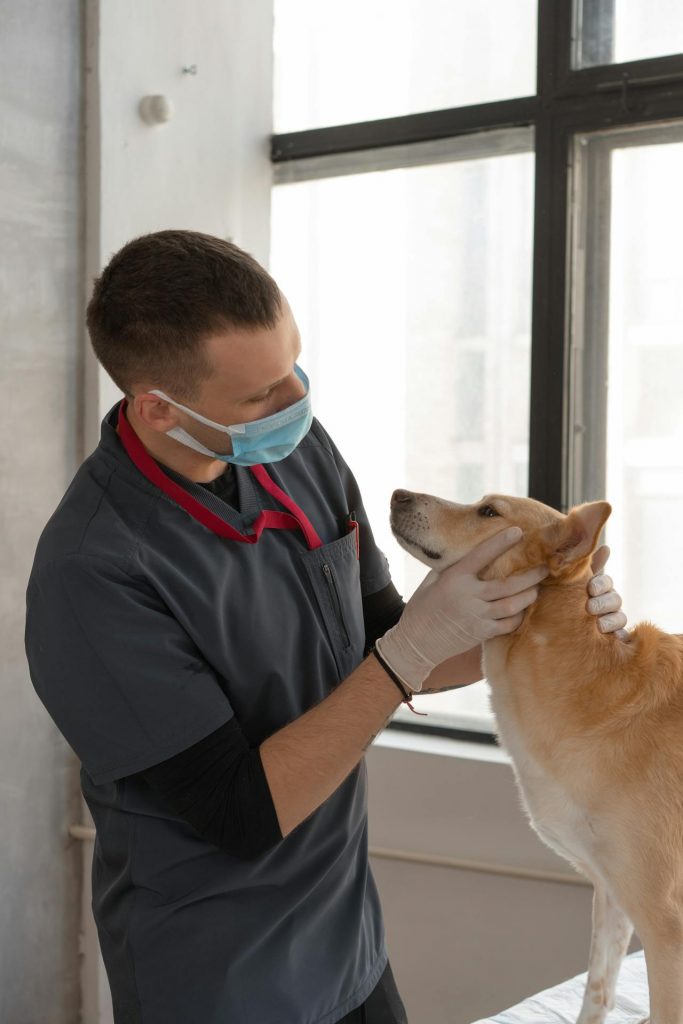
Hot spots on dogs often start as minor irritations but can quickly escalate into serious skin problems if not properly addressed. While many cases can be treated at home, knowing when to seek professional care is crucial for your dog’s recovery.
The line between home care and veterinary necessity isn’t always clear, so here are specific guidelines to help you decide.
Signs You Need Immediate Veterinary Care
Contact your veterinarian without delay if you notice any of these concerning symptoms:
- The hot spot measures larger than two inches in diameter
- The inflamed area is rapidly expanding over hours or a day
- Multiple hot spots have appeared on different parts of your dog’s body
- Your dog shows signs of extreme pain when the area is approached
- The hot spot has a foul, putrid odor (indicating severe infection)
- Yellow or green discharge is present (sign of serious bacterial infection)
- Your dog has developed a fever
- Your dog appears lethargic or shows a decrease in energy level
- Loss of appetite accompanies the skin condition
- The area around the hot spot feels unusually warm to the touch
When Home Treatment Isn’t Working
Even if your dog’s hot spot doesn’t exhibit severe symptoms, seek professional care when:
Home treatment shows no improvement within 48-72 hours. If after 2-3 days of diligent care the hot spot hasn’t improved or has worsened, contact your veterinarian.
Dogs with recurring hot spots need professional evaluation. Repeated episodes typically indicate underlying issues that require proper diagnosis and management, such as food allergies, environmental sensitivities, or parasitic problems.
What to Expect at the Veterinary Visit
A veterinary appointment for hot spots typically includes:
A thorough examination of the affected area and entire skin surface to check for additional lesions. Your vet will clip the fur around the hot spot extensively, providing better visibility and treatment access.
Laboratory tests may be conducted, especially if infection is suspected. This might include skin cytology to identify bacteria, yeast, or other pathogens.
Treatment for severe hot spots typically involves a combination approach:
- Prescription-strength antibiotics to combat infection
- Anti-inflammatory medications to reduce swelling and discomfort
- Pain relief to keep your dog comfortable during healing
- Specialized topical treatments with antimicrobial properties
- E-collars or alternative protective devices to prevent further self-trauma
Addressing the Root Cause
Veterinary care for hot spots includes investigating underlying causes. Studies from veterinary dermatologists show that recurring hot spots often stem from issues requiring specific treatment approaches:
For allergic dogs, your veterinarian might recommend allergy testing, prescription antihistamines, or specialized immunotherapy. Dogs with flea allergies benefit from comprehensive parasite control programs that address both the pet and environment.
In cases where anal gland issues or ear infections trigger hot spots, your vet can provide appropriate treatment for these primary conditions, preventing future flare-ups.
Severe or recurring hot spots often signal deeper health issues that need professional veterinary care. Recognizing warning signs and seeking timely help ensures faster recovery and less suffering for your dog.
Preventing Future Hot Spots: Keeping Your Dog’s Skin Healthy
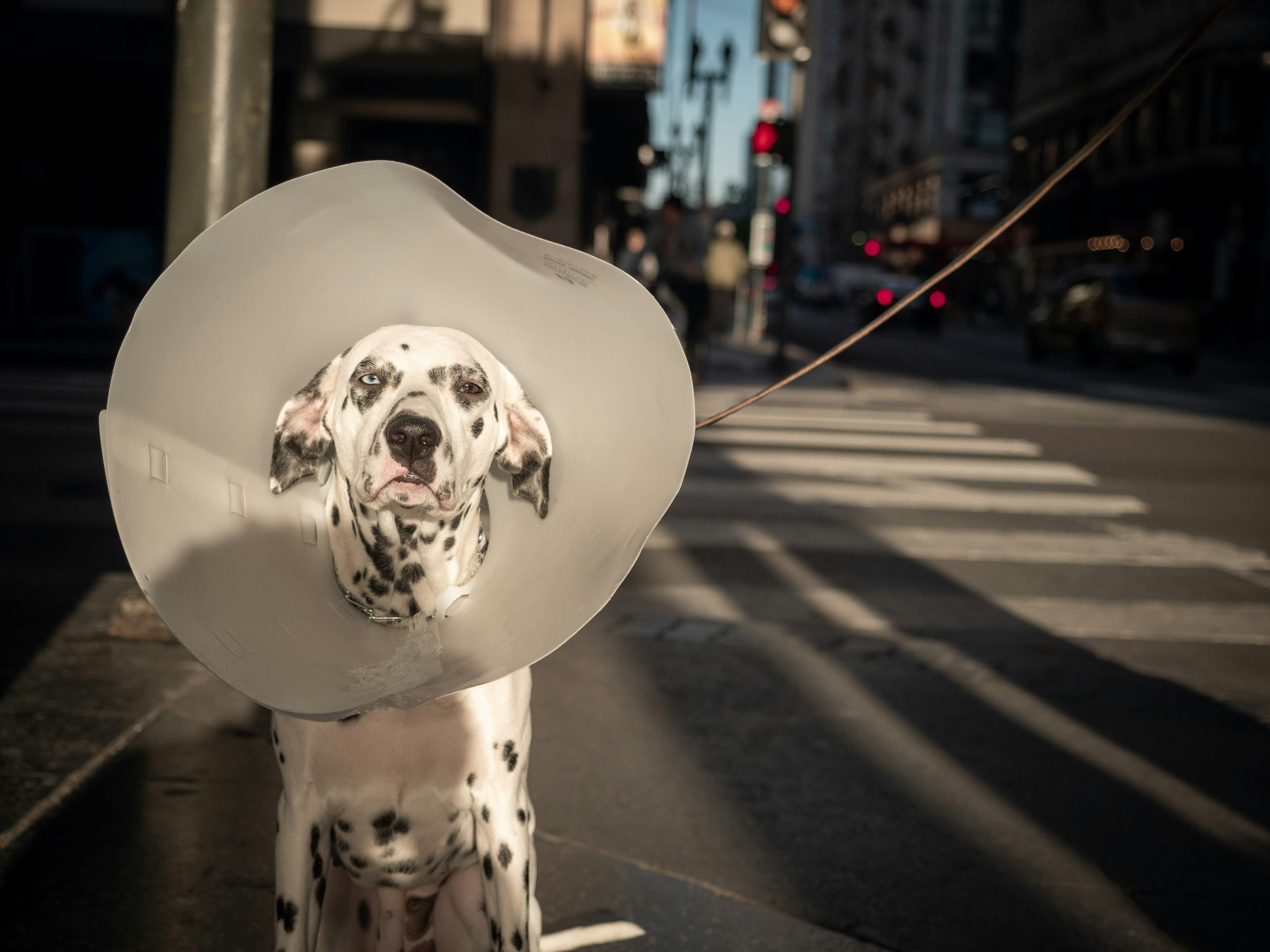
Hot spots are painful skin irritations that develop quickly but can be effectively managed through prevention. With consistent preventive measures, your dog can maintain healthy skin and avoid these uncomfortable episodes.
Regular grooming serves as your primary defense, particularly for breeds with thick or double coats. Brush your dog several times weekly to remove loose fur, prevent matting, and distribute natural skin oils. During shedding seasons, daily brushing prevents moisture-trapping buildup against the skin.
Water management is essential. Thoroughly dry your dog’s coat after swimming or baths to eliminate the damp environment where bacteria thrive. Focus on areas with dense fur, including the neck, behind ears, and under legs.
Year-round parasite control is crucial. Fleas trigger intense itching that leads to scratching and skin trauma. Maintain consistent use of vet-recommended preventives, even during winter months when parasites seem less active.
For dogs with allergies, proper diagnosis and management can significantly reduce hot spot occurrences. Collaborate with your veterinarian to identify triggers – whether environmental, food-related, or contact allergies. Treatment may include elimination diets, antihistamines, or specialized care based on specific sensitivities.
Nutrition directly impacts skin health. A balanced diet rich in essential nutrients supports your dog’s skin barrier function. Omega-3 fatty acid supplements, particularly fish oil containing DHA and EPA, can reduce inflammation and improve coat condition.
Mental and physical stimulation help prevent stress-induced hot spots. Dogs experiencing boredom or anxiety may develop excessive licking behaviors that damage the skin. Regular exercise, puzzle toys, and interactive play sessions positively channel energy and reduce compulsive behaviors.
Integrating these preventive measures into your regular pet care routine enhances your dog’s overall quality of life while preventing hot spots. This proactive approach ensures your dog maintains healthy, resilient skin and avoids the discomfort of skin conditions.
Hot Spots in Dogs: The Final Word on Prevention and Peace of Mind

Hot spots are a common skin condition that can quickly escalate without proper attention. Regular grooming, awareness of environmental triggers, and maintaining a consistent daily routine are essential for keeping your dog’s skin healthy. This is particularly important for active dogs who spend time exploring outdoors.
The Halo Collar provides GPS boundary settings that help keep dogs away from areas with high allergens or moisture, reducing hot spot risk factors. Combining smart technology with regular care and prompt attention to skin issues creates an effective prevention strategy.
For more expert advice on protecting your dog’s health from nose to tail, visit our Dog Health page.

